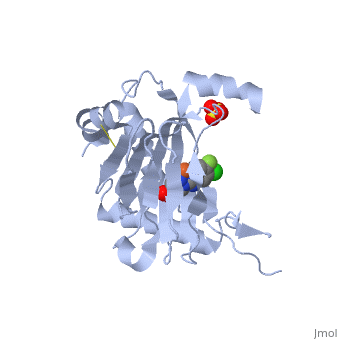3ouh
From Proteopedia
(Difference between revisions)
| Line 1: | Line 1: | ||
| + | |||
==PHD2-R127 with JNJ41536014== | ==PHD2-R127 with JNJ41536014== | ||
<StructureSection load='3ouh' size='340' side='right' caption='[[3ouh]], [[Resolution|resolution]] 2.51Å' scene=''> | <StructureSection load='3ouh' size='340' side='right' caption='[[3ouh]], [[Resolution|resolution]] 2.51Å' scene=''> | ||
== Structural highlights == | == Structural highlights == | ||
| - | <table><tr><td colspan='2'>[[3ouh]] is a 1 chain structure with sequence from [http://en.wikipedia.org/wiki/ | + | <table><tr><td colspan='2'>[[3ouh]] is a 1 chain structure with sequence from [http://en.wikipedia.org/wiki/Human Human]. Full crystallographic information is available from [http://oca.weizmann.ac.il/oca-bin/ocashort?id=3OUH OCA]. For a <b>guided tour on the structure components</b> use [http://oca.weizmann.ac.il/oca-docs/fgij/fg.htm?mol=3OUH FirstGlance]. <br> |
</td></tr><tr id='ligand'><td class="sblockLbl"><b>[[Ligand|Ligands:]]</b></td><td class="sblockDat"><scene name='pdbligand=014:1-(5-CHLORO-6-FLUORO-1H-BENZIMIDAZOL-2-YL)-1H-PYRAZOLE-4-CARBOXYLIC+ACID'>014</scene>, <scene name='pdbligand=FE2:FE+(II)+ION'>FE2</scene>, <scene name='pdbligand=SO4:SULFATE+ION'>SO4</scene></td></tr> | </td></tr><tr id='ligand'><td class="sblockLbl"><b>[[Ligand|Ligands:]]</b></td><td class="sblockDat"><scene name='pdbligand=014:1-(5-CHLORO-6-FLUORO-1H-BENZIMIDAZOL-2-YL)-1H-PYRAZOLE-4-CARBOXYLIC+ACID'>014</scene>, <scene name='pdbligand=FE2:FE+(II)+ION'>FE2</scene>, <scene name='pdbligand=SO4:SULFATE+ION'>SO4</scene></td></tr> | ||
<tr id='related'><td class="sblockLbl"><b>[[Related_structure|Related:]]</b></td><td class="sblockDat">[[3oui|3oui]], [[3ouj|3ouj]]</td></tr> | <tr id='related'><td class="sblockLbl"><b>[[Related_structure|Related:]]</b></td><td class="sblockDat">[[3oui|3oui]], [[3ouj|3ouj]]</td></tr> | ||
| - | <tr id='gene'><td class="sblockLbl"><b>[[Gene|Gene:]]</b></td><td class="sblockDat">EGLN1, C1orf12, PNAS-118, PNAS-137 ([http://www.ncbi.nlm.nih.gov/Taxonomy/Browser/wwwtax.cgi?mode=Info&srchmode=5&id=9606 | + | <tr id='gene'><td class="sblockLbl"><b>[[Gene|Gene:]]</b></td><td class="sblockDat">EGLN1, C1orf12, PNAS-118, PNAS-137 ([http://www.ncbi.nlm.nih.gov/Taxonomy/Browser/wwwtax.cgi?mode=Info&srchmode=5&id=9606 HUMAN])</td></tr> |
| - | <tr id='resources'><td class="sblockLbl"><b>Resources:</b></td><td class="sblockDat"><span class='plainlinks'>[http://oca.weizmann.ac.il/oca-docs/fgij/fg.htm?mol=3ouh FirstGlance], [http://oca.weizmann.ac.il/oca-bin/ocaids?id=3ouh OCA], [http://www.rcsb.org/pdb/explore.do?structureId=3ouh RCSB], [http://www.ebi.ac.uk/pdbsum/3ouh PDBsum]</span></td></tr> | + | <tr id='resources'><td class="sblockLbl"><b>Resources:</b></td><td class="sblockDat"><span class='plainlinks'>[http://oca.weizmann.ac.il/oca-docs/fgij/fg.htm?mol=3ouh FirstGlance], [http://oca.weizmann.ac.il/oca-bin/ocaids?id=3ouh OCA], [http://pdbe.org/3ouh PDBe], [http://www.rcsb.org/pdb/explore.do?structureId=3ouh RCSB], [http://www.ebi.ac.uk/pdbsum/3ouh PDBsum], [http://prosat.h-its.org/prosat/prosatexe?pdbcode=3ouh ProSAT]</span></td></tr> |
</table> | </table> | ||
== Disease == | == Disease == | ||
| Line 12: | Line 13: | ||
== Function == | == Function == | ||
[[http://www.uniprot.org/uniprot/EGLN1_HUMAN EGLN1_HUMAN]] Cellular oxygen sensor that catalyzes, under normoxic conditions, the post-translational formation of 4-hydroxyproline in hypoxia-inducible factor (HIF) alpha proteins. Hydroxylates a specific proline found in each of the oxygen-dependent degradation (ODD) domains (N-terminal, NODD, and C-terminal, CODD) of HIF1A. Also hydroxylates HIF2A. Has a preference for the CODD site for both HIF1A and HIF1B. Hydroxylated HIFs are then targeted for proteasomal degradation via the von Hippel-Lindau ubiquitination complex. Under hypoxic conditions, the hydroxylation reaction is attenuated allowing HIFs to escape degradation resulting in their translocation to the nucleus, heterodimerization with HIF1B, and increased expression of hypoxy-inducible genes. EGLN1 is the most important isozyme under normoxia and, through regulating the stability of HIF1, involved in various hypoxia-influenced processes such as angiogenesis in retinal and cardiac functionality.<ref>PMID:11595184</ref> <ref>PMID:12351678</ref> <ref>PMID:15897452</ref> <ref>PMID:19339211</ref> <ref>PMID:21792862</ref> | [[http://www.uniprot.org/uniprot/EGLN1_HUMAN EGLN1_HUMAN]] Cellular oxygen sensor that catalyzes, under normoxic conditions, the post-translational formation of 4-hydroxyproline in hypoxia-inducible factor (HIF) alpha proteins. Hydroxylates a specific proline found in each of the oxygen-dependent degradation (ODD) domains (N-terminal, NODD, and C-terminal, CODD) of HIF1A. Also hydroxylates HIF2A. Has a preference for the CODD site for both HIF1A and HIF1B. Hydroxylated HIFs are then targeted for proteasomal degradation via the von Hippel-Lindau ubiquitination complex. Under hypoxic conditions, the hydroxylation reaction is attenuated allowing HIFs to escape degradation resulting in their translocation to the nucleus, heterodimerization with HIF1B, and increased expression of hypoxy-inducible genes. EGLN1 is the most important isozyme under normoxia and, through regulating the stability of HIF1, involved in various hypoxia-influenced processes such as angiogenesis in retinal and cardiac functionality.<ref>PMID:11595184</ref> <ref>PMID:12351678</ref> <ref>PMID:15897452</ref> <ref>PMID:19339211</ref> <ref>PMID:21792862</ref> | ||
| + | <div style="background-color:#fffaf0;"> | ||
| + | == Publication Abstract from PubMed == | ||
| + | HIF prolyl 4-hydroxylases (PHD) are a family of enzymes that mediate key physiological responses to hypoxia by modulating the levels of hypoxia inducible factor 1-alpha (HIF1alpha). Certain benzimidazole-2-pyrazole carboxylates were discovered to be PHD2 inhibitors using ligand- and structure-based methods and found to be potent, orally efficacious stimulators of erythropoietin secretion in vivo. | ||
| + | |||
| + | Benzimidazole-2-pyrazole HIF Prolyl 4-Hydroxylase Inhibitors as Oral Erythropoietin Secretagogues.,Rosen MD, Venkatesan H, Peltier HM, Bembenek SD, Kanelakis KC, Zhao LX, Leonard BE, Hocutt FM, Wu X, Palomino HL, Brondstetter TI, Haugh PV, Cagnon L, Yan W, Liotta LA, Young A, Mirzadegan T, Shankley NP, Barrett TD, Rabinowitz MH ACS Med Chem Lett. 2010 Oct 5;1(9):526-9. doi: 10.1021/ml100198y. eCollection, 2010 Dec 9. PMID:24900242<ref>PMID:24900242</ref> | ||
| + | |||
| + | From MEDLINE®/PubMed®, a database of the U.S. National Library of Medicine.<br> | ||
| + | </div> | ||
| + | <div class="pdbe-citations 3ouh" style="background-color:#fffaf0;"></div> | ||
==See Also== | ==See Also== | ||
| - | *[[Hypoxia-inducible factor prolyl hydroxylase|Hypoxia-inducible factor prolyl hydroxylase]] | ||
*[[Prolyl hydroxylase domain|Prolyl hydroxylase domain]] | *[[Prolyl hydroxylase domain|Prolyl hydroxylase domain]] | ||
== References == | == References == | ||
| Line 20: | Line 29: | ||
__TOC__ | __TOC__ | ||
</StructureSection> | </StructureSection> | ||
| - | [[Category: | + | [[Category: Human]] |
[[Category: Clark, R]] | [[Category: Clark, R]] | ||
[[Category: Kim, H]] | [[Category: Kim, H]] | ||
[[Category: Oxidoreductase]] | [[Category: Oxidoreductase]] | ||
[[Category: Phd2]] | [[Category: Phd2]] | ||
Revision as of 06:05, 18 April 2018
PHD2-R127 with JNJ41536014
| |||||||||||
Categories: Human | Clark, R | Kim, H | Oxidoreductase | Phd2

